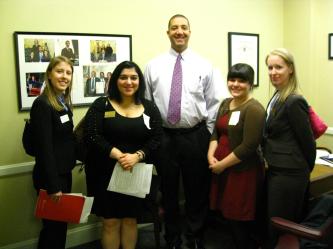Maryland Legislators Meet with SOP Student Advocates
Students ask lawmakers to help streamline collaborative drug therapy management agreements between pharmacists and physicians, and discuss other progressive health care programs.

By Steve Berberich
February 17, 2012
Key Maryland state legislators met in their General Assembly offices with student advocates from the University of Maryland School of Pharmacy on Feb. 1 to discuss progressive programs that capitalize on pharmacists’ unique skills as medication experts in saving lives and improving health care.
The annual student advocacy day is in part an opportunity for students “to remind legislators how important the role of the pharmacist is in health care,” said Natalie Eddington, PhD, FAAPS, FCP, professor and dean of the School.
The students asked the lawmakers to support legislative efforts to streamline collaborative drug therapy management agreements between pharmacists and physicians, which currently require approvals from the state Board of Pharmacy and state Board of Physicians.
David Goffman, Class of 2014, explained in detail to Del. Samuel Rosenberg of Baltimore City how patients will benefit from new legislation. “Essentially the bill in front of the House this year removes the requirement to have both boards approve collaborative protocols, but will still maintain agreements between pharmacists and physicians without waiting,” Goffman said.
The current requirement for each agreement to be approved by both boards meeting together can take months to achieve, he said, and patients are denied timely service because of the delay.
The students also reported that employers in Maryland who have signed up to participate in the innovative Patients, Pharmacists, Partnerships (P3) Program, initiated by the School in 2006, are now saving about $495 to $3,281 per employee per year in health care expenses. They asked the legislators to expand funding for the program to assist businesses and patients in their districts.
The P3 Program is a chronic disease management program supervised by pharmacists and is a collaboration of the School of Pharmacy, the Maryland Pharmacists Association, the state Department of Health and Mental Hygiene, and the Maryland General Assembly. For example, for patients with diabetes and cardiovascular diseases there has been a 5 percent reduction in coronary-related deaths and 8 percent fewer stroke-related deaths at companies in the P3 participating in the program.
“One of the great aspects of this program is that it reduces health care costs for patients as well as increases their health outcomes,” said Eddington. “We started the program with a focus on diabetes, now we’ve added hypertension, cardiovascular diseases, and asthma. We are thankful that the Maryland Department of Health and Mental Hygiene, the Maryland Pharmacists Association, and the General Assembly have supported this endeavor, and we would like to see it expanded to include state of Maryland employees.”
Many of the delegates and senators who met with the pharmacy students expressed an eagerness to advance the state’s Patient-Centered Medical Home Pilot Project. ‘Medical home’ is a concept emerging nationwide that aims to improve patient outcomes while reducing the cost of health care delivery.
The School of Pharmacy provides medication therapy management and consulting services at a pilot site at the University of Maryland School of Medicine. In a meeting with pharmacy students, Del. Adelaide Eckardt, a former nurse who represents a district on Maryland’s Eastern Shore, advised a group of students that in the future “there will be a lot of innovative arrangements for underserved regions because we don’t have enough caregivers and health professionals to meet the needs.”
Concerning the Maryland pilot program, Eckardt asked, “Is the pharmacist at that table?” Janet Lee, Class of 2013, replied, “Yes. It consists of pharmacists, nurses, physicians, and social workers. As pharmacists, our role is to provide medication therapy and consultation services, things that we have been trained to do as medication experts. It is our way of providing better care for that patient.” The Maryland medical home project consists of 53 practices across the state with 200,000 patients served so far.
The students also shared their concern for continued and stable funding for the School of Pharmacy’s life-saving round-the-clock services at the Maryland Poison Center. The center, celebrating its 40th anniversary this year, is staffed by professionals who field more than 60,000 calls a year. Callers seek advice and information on situations they have encountered with hazardous chemicals, household cleaners, medicines, snake and spider bites, industrial accidents, and more.
The Poison Center staff consists of 13 pharmacists and nurses with more than 150 years of combined experience and clinical toxicology training. Such poison services save more than $1 billion in health care costs each year, according to the U.S. Department of Health and Human Services.
Also, the students informed the legislators of a projected need for 34 percent more pharmacists by 2014 to serve low-income Marylanders. One prescription, they proposed, is to expand the state’s Janet L. Hoffman Loan Assistance Repayment Program (LARP) for students.
Hana Kim, Class of 2013, spoke with Sen. James Robey, who represents Howard County, and said, “I am not sure you are aware that pharmacists are not currently eligible for the LARP. Lawyers, doctors, dentists are all eligible, but not pharmacists.” Robey quickly demanded to know, “Why not?” and turned to a staff member to look into it.
Students from the School of Pharmacy also participated in the Maryland Pharmacy Coalition’s annual Legislative Day in Annapolis on Feb. 16, where they discussed issues of importance to the pharmacy profession, such as prescriber dispensing, expansion of vaccine services, and the establishment of a naturopathic board.
